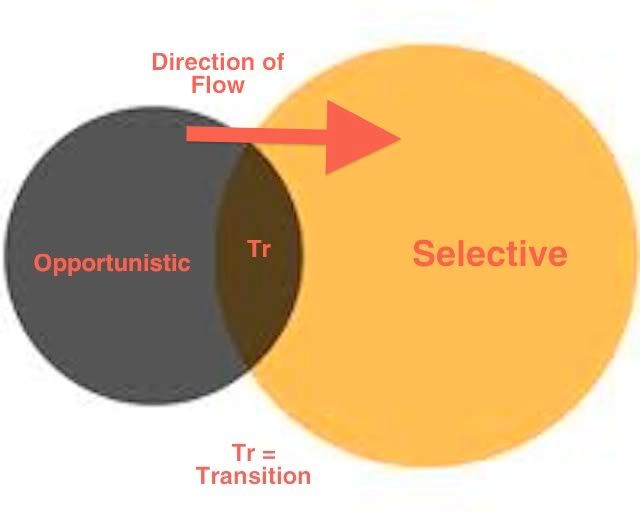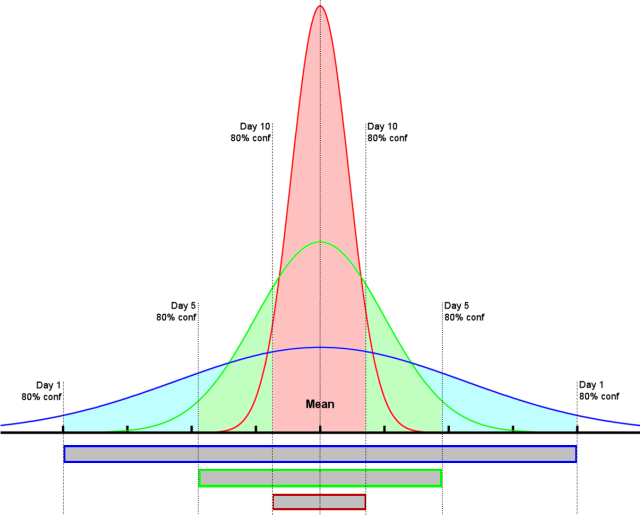
Part 2 of "How Trout Become Selective Feeders".
When discussing selectivity, or selective feeding, we must realize that we are discussing a biologic system. In any biologic system there is variation in the population and there will be a variation in behavior. So although the discussion above treats a population as a single unit of identical behavior, the reality is that there will be a variance in both behavior and timing, so that what we find is similar to a bell curve distribution. Although the majority of fish may be feeding on a given stage of emergence, some fish may be still feeding on an earlier stage or may have progressed to a later stage.
Combine this variation in behavior with overlapping or simultaneous multiple hatches, and the possibilities become confounding to the angler who is trying to "match the hatch".
This confounding behavior, however, is not a conscious attempt by the fish to fool the angler. It is just the result of an efficient feeding method superimposed on a fish population with biological variance.
Why do some fish take other forms of food when most are selective? Again it is biological variance. Fish are not automatons. There is room for variance, and in fact, if there was no reported variance in a biologic system we would suspect that the data was flawed or manufactured. It would be too good to believe.
So a fish breaking out of selectivity can mean either biologic variance in a large fish or a juvenile fish that has no need to feed as selectively to optimize its caloric intake.
It is also apparent to me that selectivity is not an all or none proposition.
What I mean by that, is that at any given moment you may have both selective and and non selective feeding. Even more confounding, the selective fish may be feeding on different stages of the hatch; or if there are multiple hatches, there may be trout that are feeding selectively on different stages of different hatches.
If you fish in waters where multiple dense hatches occur often, you will find yourself in such a situation. To say that the theory of selectivity is not valid because a fish takes a Royal Wulff during a hatch does not disprove selectivity. What it proves is that some fish will take a Royal Wulff when some or most of the other fish are feeding selectively.
Biological systems have variant behavior. To observe such behavior and state that that observation disproves a theory is simply not correct in my view. The question is not how a single individual trout may behave at a single instant in time, but how the average population behaves over a length time. An individual fish may break a selective feeding pattern to take a Royal Wulff. But my view is that this does not negate the overall behavior which is selective feeding.
Here are two Venn diagrams that illustrate what happens during a hatch and how selectivity develops.
The vertical Venn diagram below demonstrates what happens during a hatch with the nymphs turning into emergers and emergers into adults. Note that the size of each of the portions is relative to the timing of the hatch. In the diagram below, most of the nymphs that will emerge during that hatched have already turned into adults. At any given time the number of emergers is relatively small compared to the number of nymphs and adults BUT the emergers are trapped in the film so they may be small in absolute terms but they are huge relative to the number of the insects that can be taken by the fish. Most of the adults are already in the air and the majority of the remaining nymphs have not yet begun to emerge.

The longitudinal Venn diagram below shows the development of selectivity in the fish as they go through a transition phase from opportunistic to selective feeding. Before the hatch they are feeding opportunistically and as the hatch develop they become selective.

If we look at the population of trout as a population distribution of feeding behavior and graph the number of fish in the Y Axis and selectivity along the X axis we get an approximation of a bell curve. The blue curve is when most of the population is feeding opportunistically and the center of the curve gradually moves to the right to the pink scale as they become selective.

The graph below demonstrates what happens if the hatch last a long time and is regular and heavy. The population begins to cluster and feed more alike as virtually all the fish center around a core of selective behavior. There are relatively fewer and fewer outlier fish that exhibit no selective behavior. Again they move from a wide spread blue distribution to a more consistent pink bell distribution where the behavior is more uniform across all the feeding fish.

What the graphs demonstrate is an idealized situation. For this to occur in the real word, the macro and micro environment of each fish would have to be identical. Every fish would have to have access to the same number of nymphs, emergers and adults as every other fish. That cannot and does not occur in the real world.
So as you move from place to place in a river, the fishes behavior will mirror the change in environment from where your were to where you are.
Isn't that why we move from a place we are not catching fish in to a place where we hope we will catch fish in? The graphs and explanation above is the scientific underpinning of why we do what we do to catch fish as selectivity develops during a hatch.
For example, say we are faced with almost all the fish feeding super selectively as in the pink graph above. Frustrated with not being able to "match the hatch" we employ the "hatch breaker strategy" of using a fly that is completely different that the hatch but familiar to the fish when they are feeding opportunistically. So we put on an ant or a beetle or we strip a big streamer. Unfortunately this does not work and with our knowledge of what is going on with these "Red Zone" super selective fish, we decide to move.
We move and find that our hatch breaker strategy is picking up fish. Why? It is because we have found a population that is in the "Green Zone" and those at the lower end of that green bell curve are still open to feeding opportunistically to the hatch breaker fly we are presenting.
As a physician with an undergraduate degree in chemistry, I know that theories are propositions that seem to correlate with reality. By that I mean that theories do no have to be absolutely true for them to be of usefulness. All they need to do is to predict or explain behavior such that we can use the theories to help us remember how the world works and to predict what will occur.
What do I mean by the above? As an example we can use Newtonian physics which explains and predicts the motion of planets. Newton believed that gravity was due to the attraction of heavenly bodies. We now know that Newton was wrong. Einstein showed that gravity is actually a wave that is pushed out from an object that distorts space. Well so what?
Well, it is apparent to me that even if Newton's theory was wrong, we can still use Newton's laws of gravitation to predict the motion of heavenly bodies. It may be wrong but it correctly predicts what happens and what will happen.
Therefore, the theory of selectivity does not have to be absolutely true. If selectivity explains the behavior of a fish and predicts what will happen during a hatch, it gives us useful information and gives us a framework with which to understand and predict behavior.
Selectivity and any other "theory" of fishing does not have to be absolutely true. It just has to explain and predict behavior better than a competing theory.
Last edited by Silver Creek; 08-25-2014 at 06:34 PM.
Regards,
Silver
"Discovery consists of seeing what everybody has seen and thinking what nobody has thought"..........Szent-Gyorgy








 Reply With Quote
Reply With Quote